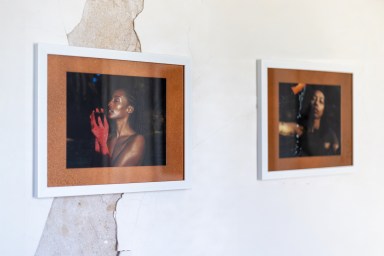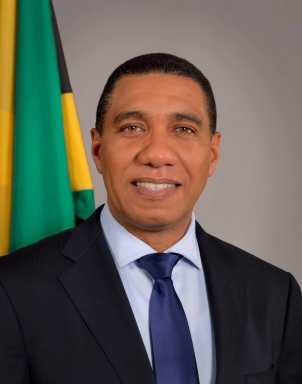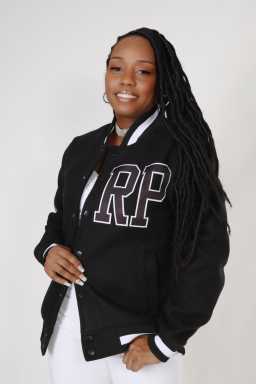Listeners:
Top listeners:
-
play_arrow
RadioJLR Just Press Play
Superposition Gallery hosts exhibition spotlighting artist of Caribbean heritage

The exhibition of artist Patricia Encarnación, “Tracing the Underside: The Epigenetics of Tropicalization,” is on display until Oct. 27 at New Art Dealers Alliance (NADA) House 17, 2nd floor, at Nolan Park on Governors Island after opening on Sept. 3.
The exhibition is being done in collaboration with Superposition Gallery, which Storm Ascher founded in 2018. It explores the intricate relationship between Caribbean bodies and landscapes as territories that withhold memories. The project employs a photo documentary-style approach, focusing on self-portraits and portraits highlighting the resilience and transformative potential of adaptation.
In sharing more about what led Ascher to establish the gallery, she said, “I was working in galleries throughout college, and it grew difficult to find a practical reason why valuable artworks had more real estate than the community that inspired these very objects’ existence.”
The most significant influence that Ascher has had on her path was her grandfather, who has spent his life in the field of policy sciences as a government/economics professor. He has also written many books about how to aid the poorest populations affected by the policies he’s suggesting to replace.
Ascher remembers many dinner conversations during which she “would try to convince him to include in his policies that borders and countries are just a figment of the imagination that we have no borders, and all of the worlds belongs to all of us.”
Ascher then explained that this collaboration was really born out of travel, as she and Encarnación found themselves in Santo Domingo at the same time, where Encarnación was born and raised. Many of their friends were there for MECA, an art fair bringing together American, Latin American, and Caribbean artists.
“It was my first time participating in the fair, and she was also curating a group exhibition of Dominican artists down the street in a historic home. We had met many times before in NYC and had similar experiences and interests, but traveling with someone creates a different dynamic. I wanted to honor that experience that I had a glimpse of because she welcomed the community into her neighborhood and her nature. I thought it would be great to do the reverse and bring that energy back to NYC,” she added.
Encarnación then shared more about her family background. “My mom is a retired salonera (hairdresser), and my dad, un joseador (a hustler), has had many jobs, from owning sugar cane carts to working at the botanical garden and a public state department called Desarrollo Fronterizo (Border Development), focusing on the towns along the shared border with Haiti,” she said.
She added that growing up with this background “exposed me to diverse communities and realities in the Dominican Republic, expanding my understanding beyond the national identity shaped by the colonial legacies of ‘dominicanidad.’”
Her parents were hard workers, and they rose in social class during the ’90s. Though not particularly critical of the state, they were brilliant in their appreciation for the power of knowledge, always encouraging her to read, build skills, and sustain my beliefs.
Encarnación then shared a few of the life experiences that she has had which have shaped her artwork.
The hair salon where her mom worked was “one of the few safe havens for women and feminized individuals, where they could be completely free and exchange ideas and emotions.”
Having several interactions with women there gave her an understanding of womanhood and, to an extent, led me to reject conventional beauty standards at a young age. “On the other hand, my first feminist sentiments were sparked by seeing women unite and create ways to support one another — something I haven’t seen as much in other spaces,” she continued.
Another experience that has impacted her work was traveling with her dad along the border of Haiti and the Dominican Republic.
“It allowed me to understand that we are one island — Haitians and Dominicans are not as different as the state portrays. Both communities can live in peace, and above all, we are human. That experience dismantled the construction of ‘otherness’ for me,” she stated.
In addition, Moving to New York City to attend Parsons was a formative experience for her.
“As a transfer student, I got to see different educational systems, and I realized that the U.S. wasn’t particularly special—nepotism works on different scales everywhere. The biggest difference was access to resources, which was mind-blowing for me. For the first time, I had access to materials I had never worked with before, including ceramics, and that’s when I discovered one of my current passions.”
According to Encarnación, the creation of these pieces came about naturally, as she was surrounded by her closest friends.
“Our conversations became a way for me to develop tools for healing, caring, and creating. The photographs are moments of exploration, capturing how we connect with nature, both individually and as a group. I carried the lens to document these moments, and as our conversations deepened, the vision for this project unfolded in front of me like a manifestation. As I continue working on it, I hope the intention of healing and cleansing becomes even more powerful and clear,” she stated.
In developing this project, she has drawn inspiration from Krista Thompson’s ‘An Eye for the Tropics“ and Edouard Glissant’s “Caribbean Discourse.“ She added, “Their work has helped me deepen my understanding of the concepts and themes that drive this project forward.”
Encarnación wants her legacy to reflect a commitment to healing and understanding across cultures.
She hopes to inspire others “to explore their identities and histories, fostering connections that transcend boundaries. I want to see my people healed and free. Freedom is a complex concept, but I want them to treasure their land, to stop admiring empires, and to find salvation in what fulfills their souls, not just their pockets. I want them to love themselves.”
Furthermore, she envisions a healed future, where she is among the last forced to emigrate, feeling that I have no options back home.
“I want my art to serve as a tool for finding that freedom, encouraging radical imagination and a vision for a more inclusive world. Ultimately, I hope to leave behind a body of work that challenges existing narratives and creates spaces where voices are amplified. Stories are shared, particularly those of marginalized communities,“ she stated.
Those interested in attending and who have questions can email Ascher from Superposition Gallery at [email protected].
Similar posts
© 2025. All Rights Reserved by Radio-JLR



Post comments (0)